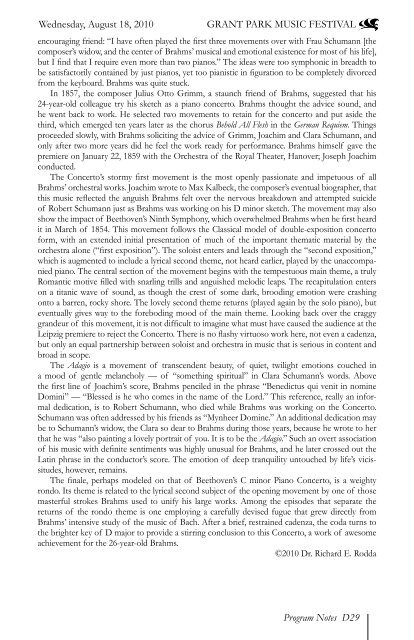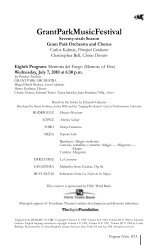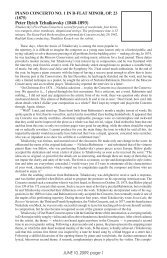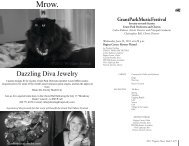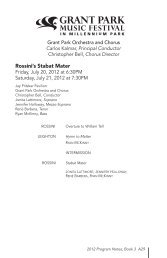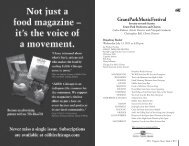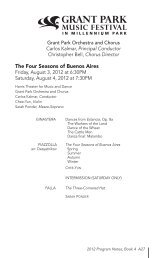cute Brahms Bizet.pdf - The Grant Park Music Festival
cute Brahms Bizet.pdf - The Grant Park Music Festival
cute Brahms Bizet.pdf - The Grant Park Music Festival
Create successful ePaper yourself
Turn your PDF publications into a flip-book with our unique Google optimized e-Paper software.
Wednesday, August 18, 2010<br />
GRANT PARK MUSIC FESTIVAL<br />
encouraging friend: “I have often played the first three movements over with Frau Schumann [the<br />
composer’s widow, and the center of <strong>Brahms</strong>’ musical and emotional existence for most of his life],<br />
but I find that I require even more than two pianos.” <strong>The</strong> ideas were too symphonic in breadth to<br />
be satisfactorily contained by just pianos, yet too pianistic in figuration to be completely divorced<br />
from the keyboard. <strong>Brahms</strong> was quite stuck.<br />
In 1857, the composer Julius Otto Grimm, a staunch friend of <strong>Brahms</strong>, suggested that his<br />
24-year-old colleague try his sketch as a piano concerto. <strong>Brahms</strong> thought the advice sound, and<br />
he went back to work. He selected two movements to retain for the concerto and put aside the<br />
third, which emerged ten years later as the chorus Behold All Flesh in the German Requiem. Things<br />
proceeded slowly, with <strong>Brahms</strong> soliciting the advice of Grimm, Joachim and Clara Schumann, and<br />
only after two more years did he feel the work ready for performance. <strong>Brahms</strong> himself gave the<br />
premiere on January 22, 1859 with the Orchestra of the Royal <strong>The</strong>ater, Hanover; Joseph Joachim<br />
conducted.<br />
<strong>The</strong> Concerto’s stormy first movement is the most openly passionate and impetuous of all<br />
<strong>Brahms</strong>’ orchestral works. Joachim wrote to Max Kalbeck, the composer’s eventual biographer, that<br />
this music reflected the anguish <strong>Brahms</strong> felt over the nervous breakdown and attempted suicide<br />
of Robert Schumann just as <strong>Brahms</strong> was working on his D minor sketch. <strong>The</strong> movement may also<br />
show the impact of Beethoven’s Ninth Symphony, which overwhelmed <strong>Brahms</strong> when he first heard<br />
it in March of 1854. This movement follows the Classical model of double-exposition concerto<br />
form, with an extended initial presentation of much of the important thematic material by the<br />
orchestra alone (“first exposition”). <strong>The</strong> soloist enters and leads through the “second exposition,”<br />
which is augmented to include a lyrical second theme, not heard earlier, played by the unaccompanied<br />
piano. <strong>The</strong> central section of the movement begins with the tempestuous main theme, a truly<br />
Romantic motive filled with snarling trills and anguished melodic leaps. <strong>The</strong> recapitulation enters<br />
on a titanic wave of sound, as though the crest of some dark, brooding emotion were crashing<br />
onto a barren, rocky shore. <strong>The</strong> lovely second theme returns (played again by the solo piano), but<br />
eventually gives way to the foreboding mood of the main theme. Looking back over the craggy<br />
grandeur of this movement, it is not difficult to imagine what must have caused the audience at the<br />
Leipzig premiere to reject the Concerto. <strong>The</strong>re is no flashy virtuoso work here, not even a cadenza,<br />
but only an equal partnership between soloist and orchestra in music that is serious in content and<br />
broad in scope.<br />
<strong>The</strong> Adagio is a movement of transcendent beauty, of quiet, twilight emotions couched in<br />
a mood of gentle melancholy — of “something spiritual” in Clara Schumann’s words. Above<br />
the first line of Joachim’s score, <strong>Brahms</strong> penciled in the phrase “Benedictus qui venit in nomine<br />
Domini” — “Blessed is he who comes in the name of the Lord.” This reference, really an informal<br />
dedication, is to Robert Schumann, who died while <strong>Brahms</strong> was working on the Concerto.<br />
Schumann was often addressed by his friends as “Mynheer Domine.” An additional dedication may<br />
be to Schumann’s widow, the Clara so dear to <strong>Brahms</strong> during those years, because he wrote to her<br />
that he was “also painting a lovely portrait of you. It is to be the Adagio.” Such an overt association<br />
of his music with definite sentiments was highly unusual for <strong>Brahms</strong>, and he later crossed out the<br />
Latin phrase in the conductor’s score. <strong>The</strong> emotion of deep tranquility untouched by life’s vicissitudes,<br />
however, remains.<br />
<strong>The</strong> finale, perhaps modeled on that of Beethoven’s C minor Piano Concerto, is a weighty<br />
rondo. Its theme is related to the lyrical second subject of the opening movement by one of those<br />
masterful strokes <strong>Brahms</strong> used to unify his large works. Among the episodes that separate the<br />
returns of the rondo theme is one employing a carefully devised fugue that grew directly from<br />
<strong>Brahms</strong>’ intensive study of the music of Bach. After a brief, restrained cadenza, the coda turns to<br />
the brighter key of D major to provide a stirring conclusion to this Concerto, a work of awesome<br />
achievement for the 26-year-old <strong>Brahms</strong>.<br />
©2010 Dr. Richard E. Rodda<br />
Program Notes D29


